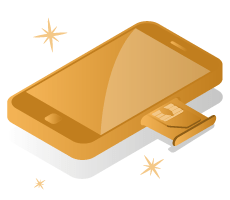What Happens If Your Mobile Provider Goes Out of Business?
With so many mobile providers offering cheap plans and flexible options, it’s no surprise that Aussies often choose smaller or newer telcos to save on their monthly phone bills. But what happens if your mobile provider suddenly shuts down? While it's uncommon, mobile providers can go out of business due to financial pressure, mergers, or wholesale network contract changes. The good news is that you won’t lose your phone number or mobile service forever—as long as you act quickly.
How Common Is It for Mobile Providers to Shut Down?
Australia’s mobile market is made up of three major networks, Telstra, Optus and Vodafone, and a long list of smaller resellers known as MVNOs (Mobile Virtual Network Operators). These smaller telcos use the infrastructure of the big three to offer mobile services, often at lower prices.
While the vast majority of providers are stable, there have been a few cases where MVNOs have closed or merged, such as Vaya Mobile in 2020, Jeenee Mobile in 2019, or Circles.life in 2025. When this happens, customers are usually given notice and moved to another provider.
Will I Lose My Mobile Service?
Not immediately. If your mobile provider goes out of business, you’ll typically receive an email or text advising of the shutdown, and you’ll be given a timeframe to switch providers. You won’t be disconnected without warning—but you do need to port your number quickly to avoid losing access.
If you don’t move your number in time, you may temporarily lose mobile access or risk having your number deactivated.
Need Help Finding a New Internet or Mobile Plan?
Our experts are available to help you free of charge:

Need Help Finding for a New Internet or Mobile Plan?
Our experts are available to help you free of charge:
Can I Keep My Mobile Number?
Yes. You can keep your mobile number by porting it to a new provider. This process is protected under Australian telecommunications rules and is usually completed within minutes or a few hours.
When porting your number, you’ll need:
- Your mobile number
- Your date of birth or account reference (used for ID verification)
- A SIM from your new provider
Most major and smaller telcos support number transfers—even between networks.
What Should I Do If My Mobile Provider Closes?
If you've been told your mobile provider is shutting down, here’s what to do:
- Read the notice carefully – It will usually include a timeline for disconnection and any available options.
- Choose a new mobile plan – Use a comparison tool to find a plan with similar data and price.
- Port your number – Sign up with your new provider and follow the prompts to transfer your number.
- Activate your new SIM – Once your old service deactivates, your new SIM will take over.
If your mobile provider is part of a larger telco group, your plan may simply be moved over to another brand automatically.

Do I Need to Pay a Final Bill?
Yes. You’ll still need to settle any outstanding charges from your previous provider, even if they’ve announced closure. If the company has gone into administration, you might receive a final invoice from a third party.
You should also check for:
- Unused credit (prepaid customers)
- Final plan charges (postpaid customers)
- Any device repayment contracts
Will I Need a New SIM Card?
In most cases, yes. When switching to a new mobile provider, you’ll be sent a new SIM card to activate. Some eSIM-compatible phones allow you to skip the physical SIM entirely and activate your service digitally.
To avoid service gaps, activate your new SIM as soon as your old provider gives you the go-ahead to switch.

Can I Trust Smaller Mobile Providers?
Smaller mobile providers—like Amaysim, Boost, Kogan Mobile and Dodo—often offer better pricing, no lock-in contracts, and great customer support. Many are backed by larger telco groups or use the same networks as the big three.
While there’s always a small risk of disruption if a provider exits the market, switching is simple and protections are in place to help you keep your number.
Should I Switch to a Bigger Telco Just to Be Safe?
Not necessarily. If your current plan offers great value and you're happy with the coverage, there’s no reason to switch unless you notice poor service, price hikes, or receive notice of closure.
That said, if stability and long-term support are important to you, it may be worth considering a provider with a larger customer base or direct network access.
What Can I Do to Protect Myself?
Here are a few tips to stay ahead of any potential disruptions:
- Avoid long-term contracts if you’re with a smaller telco.
- Keep your mobile account info up to date, including your date of birth for verification.
- Use prepaid or month-to-month plans for easier switching.
- Compare mobile plans regularly to make sure you're still getting good value.
If your mobile provider has announced its closure, or you're looking for a better deal, Selectra can help you compare and switch quickly—without losing your number.
How to Monitor Provider Stability
It’s wise to keep an eye on industry news and official communications from your mobile provider, as early notice of mergers or market exits can help you prepare for a smooth transition. Consider signing up for provider newsletters or following regulatory updates at the Australian Communications and Media Authority (ACMA) website to stay informed about changes in the mobile sector.
Frequently Asked Questions: If Your Mobile Provider Shuts Down
How common is it for mobile providers to close in Australia?
It’s not common, but it does happen occasionally,especially among smaller brands or MVNOs that rely on the major networks. Reasons include financial trouble, mergers, or major network transitions. Customers usually get advance notice and the chance to switch without sudden loss of service.
Will I lose service immediately if my provider closes?
No. Providers will notify you by email or SMS and give instructions for transferring your number and service. You’ll typically have a window of days or weeks to port your number and avoid being cut off. If you don’t move your number in time, temporary loss of service or number deactivation could occur.
Can I keep my mobile number?
Yes. Australian number porting rules guarantee you can transfer your number to any new provider. This process is simple, secure, and usually takes just a few minutes to a few hours. You’ll just need your account info and a new SIM card (or eSIM-enabled phone).
What steps should I take if my mobile provider closes?
- Carefully read all notifications and note deadlines to switch.
- Choose a new provider and plan that fits your needs and budget.
- Sign up and start the porting process for your old number.
- Insert the new SIM (or set up eSIM) and complete activation.
- Pay any final bill and check your account for credits or device repayments.
Will I need a new SIM card?
Yes, in most cases your new provider will issue a fresh SIM card, which you should activate promptly. eSIM-capable phones may let you skip the physical SIM and get connected even faster.
Are small mobile providers risky?
Most smaller brands use the same networks as the big three and offer strong value, but some are more susceptible to market changes or closures. Many are backed by larger companies, so check for ownership and read recent reviews if you’re concerned.
How can I protect myself from mobile service disruption?
- Avoid locking into long-term contracts with small telcos.
- Ensure your account info is current for quick identity verification.
- Favour month-to-month or prepaid options so you can switch easily.
- Regularly compare mobile plans and keep a shortlist of alternatives.
Click below to find a better deal for your home!

